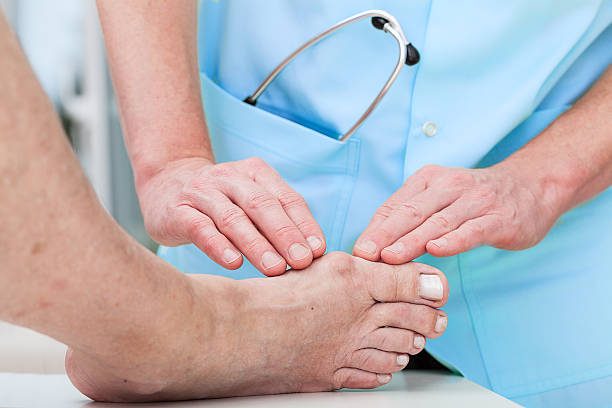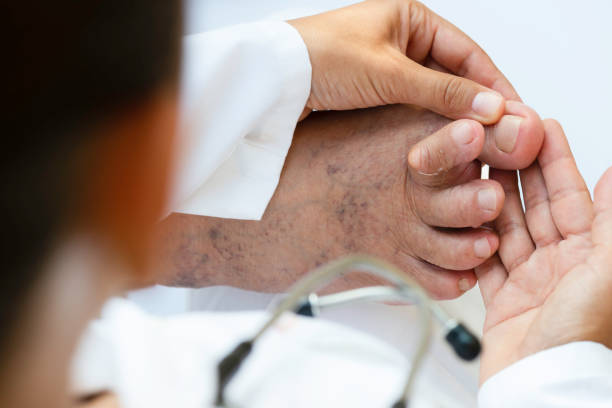Bunion and hammertoe symptoms can be managed with conservative treatments, especially in the early stages of these deformities. Padding, shoe inserts and toe exercises can help shift pressure away from the toes, easing pain and discomfort.
Bunions can cause discomfort and lead to other foot issues if left untreated. They typically develop from a shoe size imbalance, which causes the big toe to push over on to the second toe.

Orthotics
While bunions and hammertoes are distinct conditions, they share similar causes: wearing tight shoes that force the toes into unnatural positions. Both conditions can cause pain, corns and calluses that may need to be trimmed by your podiatrist. Both also can lead to deformities that affect the function of your foot.
Bunion treatment usually focuses on relieving pressure and preventing the bunion from getting worse. Non-surgical options include avoiding activities that put pressure on the bunion, taking anti-inflammatory medication and adding pads to cushion the area. The Foot Clinic doctor may recommend shoe inserts or orthotics designed to restore proper foot function and prevent recurrence of the condition.
Hammertoes develop when there’s an abnormal bend in the middle joint of a toe, causing it to curve downward like a hammer or claw. It can happen to the smallest toe (also called a pinky toe) or to any of the other four toes. A hammertoe can be flexible, meaning the toe can still bend, or rigid, where the toe can’t move.
The treatment for a hammertoe depends on whether it’s flexible or rigid, and your podiatry clinic near Wembley will determine the best course of action based on an examination of your toe and foot. The most common treatments are toe exercises and splinting, which straighten the toe and bind it to the toe next to it. These help eliminate friction and relieve pain. Your podiatrist can also recommend putting padding in your shoe to cushion the toe and prevent irritation.
Medical Tape & Splints
If your bunion or hammer toe becomes painful and you aren’t seeing the results of over-the-counter solutions, Florida Foot and Ankle Associates is here to help. Pritesh Patel, DPM, and his team offer targeted treatment that includes splints for hammer toe and bunion relief.
A bunion forms when the big toe joint moves out of alignment. This forces the middle of the toe to bend upward, resulting in a bump that looks like a hammer.
Other toe deformities can also cause painful hammer toes. One common variation is called mallet toe, which causes the second toe to become stuck in a downward position (this occurs when the middle and proximal joints bend upward). Another form of hammer toe involves four of the small toes at once. This happens when the middle and proximal joints are in hyperextension, while the distal ones are in flexion (this happens when the toes bend down).
In many cases, hammer toes can be treated using the same methods as bunions, such as shoe modifications and over-the-counter orthotics. Other options include toe splints that help stretch the toes. These can be purchased over the counter or at most pharmacies and runner stores. Lastly, toe spacers can be placed between your toes, but the benefit is only temporary.
People who are prone to developing hammer toes include those with flat feet, low arches, or arthritis. They also may be aggravated by poor-fitting shoes or high heels.

Anti-Inflammatory Medication
NSAIDs like ibuprofen can help reduce pain from hammertoes, especially when inflammation is present. Other at-home treatments for hammertoes can include using corn pads to shield painful spots and splinting or taping to straighten the bent toe. Practicing exercises that strengthen foot muscles and improve alignment may also provide relief from hammertoes.
Hammertoes are a progressive condition that develops when there’s an abnormal bend in the middle joint of a toe, causing it to flatten and point downward. There are a variety of different types of hammertoes, including tailor’s bunions, mallet toes, claw toes and brachymetatarsia. These conditions can cause a hard bump to form on the top of the toe or between two toes and can lead to open sores and pain.
Treatment for hammertoes should begin right away, especially when the condition is first noticed. A healthcare provider should visually examine your toes, feel the joints for tightness and assess your range of motion and flexibility. X-rays may be ordered for a more detailed evaluation of the joint and bone structure.
Nonsurgical options are available for hammertoes, and your podiatrist will recommend them when they think they can help. These include wearing shoes with ample toe space, using padding or orthotic devices to cushion and support the foot, splinting or taping the toe to minimize pressure and anti-inflammatory medications or cortisone injections to alleviate pain and decrease swelling. In severe cases, surgery may be required to remove the bump of bone, correct changes in the bone structure and treat the affected toe’s alignment.
Surgery
Jennifer didn’t want to accept that surgery was her only solution, but her pain and the difficulty she had with shoes finally got to the point where it was no longer a choice for her. She’d tried all of the conservative treatments, and she was at a point where her hammertoes were really starting to impact her life.
The good news is that hammertoes are more flexible in their early stages and can often be corrected with noninvasive treatment. However, if they are left untreated, they will become more rigid and will no longer respond to noninvasive treatment options.
If you think you have a hammertoe, it is important to see a foot and ankle surgeon right away. Early treatment is essential in order to prevent the deformity from worsening over time.
Your foot and ankle surgeon will perform a physical examination and may take x-rays of your foot and toes. They will try to reproduce your symptoms by manipulating your toes and feet and will study the x-rays to see the extent of the deformities. In some cases, your doctor may suggest that the digit be repositioned and the joint stabilized by cutting or removing small sections of bone and then fusing the bones together. This is called arthrodesis. A wire may be inserted to hold the bones in place while they fuse.